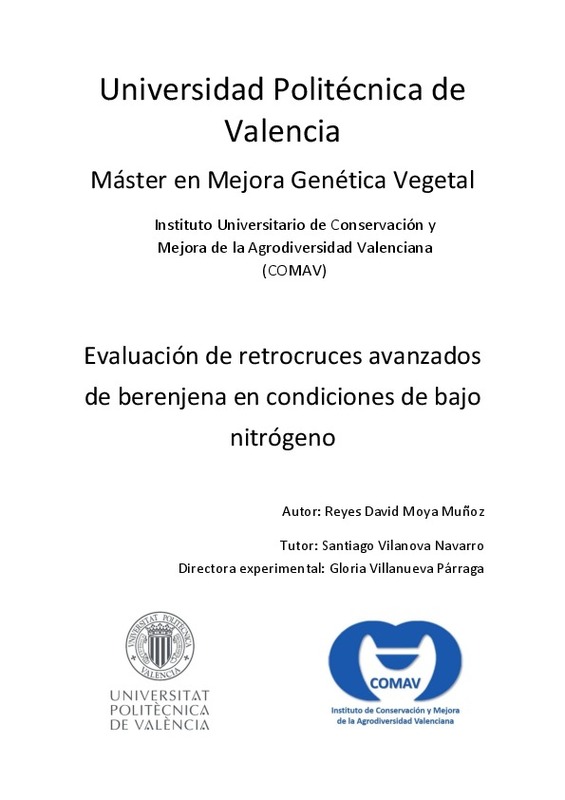|
Resumen:
|
[ES] La berenjena (Solanum melongena) es una hortaliza muy importante en muchas áreas tropicales y subtropicales del mundo, siendo la tercera solanácea más producida a nivel mundial. Sin embargo, los recursos genéticos y ...[+]
[ES] La berenjena (Solanum melongena) es una hortaliza muy importante en muchas áreas tropicales y subtropicales del mundo, siendo la tercera solanácea más producida a nivel mundial. Sin embargo, los recursos genéticos y las herramientas biotecnológicas para su investigación no han sido desarrollados lo suficiente. Por otro lado, el aporte de N en la agricultura tiene un coste medioambiental considerable, haciendo necesaria la adaptación del sistema de cultivo hacia uno de bajos insumos. La berenjena se encuentra en una situación de vulnerabilidad ante estos cambios debido a los efectos de cuello de botella genético acontecidos durante su domesticación y a la disponibilidad limitada de recursos genéticos accesibles para su mejora genética. Con el objetivo de crear material pre-mejora que pueda servir para aumentar la diversidad fenotípica en futuros programas de mejora, García-Fortea y colaboradores (2020), se encuentran desarrollando en el COMAV tres líneas de introgresión (ILs) con material proveniente de tres especies representantes de los distintos grupos del acervo genético de la berenjena S. insanum, S. dasyphyllum, y S. elaeagnifolium. En el presente Trabajo Fin de Máster, se seleccionaron un total de 143 ILs de dicha colección y se evaluaron en condiciones de bajo nitrógeno, comparándolas además con los parentales recurrentes. Se observaron efectos significativos de las condiciones de cultivo de alto y bajo nitrógeno en los parentales recurrentes. Entre las líneas se observó una gran variabilidad y se encontraron diferencias significativas para algunos caracteres de importancia agronómica como el peso del fruto, o en la eficiencia de utilización de nitrógeno (NUtE) en algunas de las ILs evaluadas, encontrándose además genotipos con unas características agronómicas superiores a las mostradas por los parentales. La evaluación de estos materiales puede contribuir al desarrollo de nuevas variedades de berenjena mejoradas para una agricultura más sostenible.
[-]
[EN] Aubergine (Solanum melongena) is a very important vegetable in many tropical and
subtropical areas of the world, being the third most produced solanaceae worldwide. However,
genetic resources and biotechnological ...[+]
[EN] Aubergine (Solanum melongena) is a very important vegetable in many tropical and
subtropical areas of the world, being the third most produced solanaceae worldwide. However,
genetic resources and biotechnological tools for its study have not been sufficiently developed.
On the other hand, N input in agriculture has a significant environmental cost, making it
necessary to adapt the cultivation system towards a low-input system. Aubergine is vulnerable
to these changes due to the genetic bottleneck effects that occurred during its domestication
and the limited availability of available genetic resources for breeding.
With the aim of creating pre-breeding material that can be used to increase phenotypic
diversity in future breeding programmes, García-Fortea and collaborators (2020) are developing
at COMAV three introgression lines (ILs) with material from three species representing the
different groups of the aubergine gene pool S. insanum, S. dasyphyllum, and S. elaeagnifolium.
In this Master's thesis, a total of 143 ILs were selected from this collection and evaluated under
low nitrogen conditions and compared with the recurrent parents. Significant effects of high and
low nitrogen growing conditions were observed in the recurrent parents. Among the lines, a
large variability was observed and significant differences were found for some agronomically
important traits such as fruit weight, or in nitrogen utilization efficiency (NUtE) in some of the
ILs evaluated, and genotypes with higher agronomic characteristics to those shown by the
parents were also found. The evaluation of these materials may contribute to the development
of new improved aubergine varieties for a more sustainable agriculture.
[-]
|







